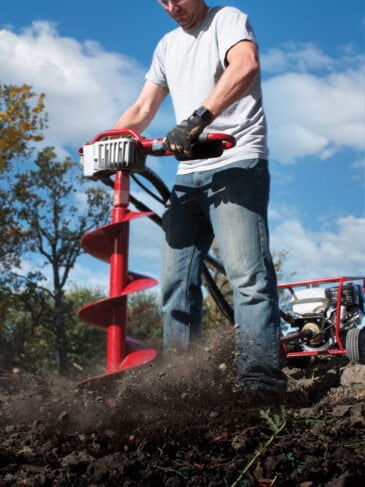How to solve problems preventing your mechanical drill from working properly

For more than 50 years, Little Beaver earth drills have been the #1 choice of rental store owners, fencing contractors and other professionals who want a one-man auger that’s safe and simple to operate.
There’s nothing more frustrating than your mechanical earth drill not performing the way you want it to. For more than 50 years, Little Beaver earth drills have been the #1 choice of rental store owners, fencing contractors and other professionals who want a one-man auger that’s safe and simple to operate. We’re dedicated to your success and have an extensive list of FAQs to address operation and maintenance questions. Check out solutions to some of the most common questions we receive about operating our mechanical earth drills.
The Drill Doesn’t Start
If you’re having trouble starting your mechanical earth drill and you’ve checked the fuel levels, there are a couple things you can try to get it working properly.
We incorporate an engine kill switch on the operating handles to allow quick fingertip control of the shut off for both safety and convenience. Often overlooked, this switch can be the culprit and an easy fix to a drill that will not start. There is also a switch incorporated in the torque tube bracket that will prevent the unit from running unless the torque tube is installed. This switch provides added safety and operator protection.
If the switch isn’t the culprit, take a moment to inspect your spark plugs. Clear indications that the spark plugs need to be changed include an engine that misfires, surges or consumes significant fuel. While you’re at it, we also recommend checking the engine oil. Although the engine has an alert that prevents operation when levels are too low, proactively checking the levels can save time and avoid hassle in the future.
Getting an Auger “Unstuck”
Occasionally, when drilling, you may encounter soils or circumstances that prove challenging for even the most powerful drills. If your auger is stuck in the ground, disconnect the handle/gearbox. Then use a pipe wrench on top of the auger to turn it in a counter clockwise direction. Be very careful not to damage the auger top.
If the pipe wrench is not successful, we do offer a specially designed tool for this situation. Part #9022-T is a Tee Handle. This handle is used in place of the pipe wrench for added leverage. You can order a Tee Handle by calling 936-327-3121.
To prevent this situation in the future, make sure not to push down on the auger when digging in soft clay or sandy soil. Let the drill do the work to efficiently cut its way through the soil.
Getting the Auger to Turn When the Engine is On
If your engine runs but the auger doesn’t turn, a problem with the drive train is the most likely situation. Frequently, the issue can be traced back to the flexible shaft core. The best way to determine if the flex shaft is the issue is to inspect the core end fittings for cracks or breakage. If the flex shaft core appears to be undamaged, check the key on the clutch drum, the gears or shaft keys within the gearbox and the adapter key on the gearbox output shaft for signs of damage.
If you find damage to the flex shaft or an issue with the gearbox, get in touch with our team to get the necessary repair parts and tips on how to prevent future damage. If both look fine but the auger still doesn’t turn, contact us or check your maintenance manual for further information on this issue.
Keeping the Auger Still When Not Engaged
If your auger turns all the time – even when not engaged – try adjusting the engine idle. If you’re unable to adjust to a low enough level to prevent turning when not engaged, replace the springs on your centrifugal clutch. To get the replacement springs and any tips on how to install them, contact us at 936-327-3121.
When an auger is working properly, the springs in the centrifugal clutch adjust when the auger is engaged so the clutch shoes push back and forth against the clutch housing to propel the auger. When not engaged, the clutch shoes stay still, so the auger stops turning. As the springs wear down, they loosen so the clutch shoes always pulse against the clutch housing.
To help reduce wear on the springs, make sure not to “bog down” the engine when using the drill. It’s important to let the auger turn fast enough that the clutch doesn’t slip because excessive slippage will cause overheating and loss of temper of the springs.
If you’re still not finding what you’re looking for, take a deeper look into our service FAQs for mechanical earth drills or check out our owner’s manual. If the answer to your problem still isn’t coming up, don’t despair! Contact us to speak with a member of our team for a personalized solution.